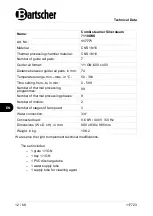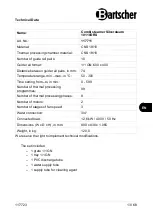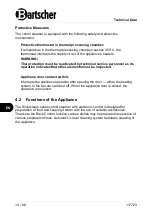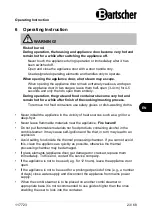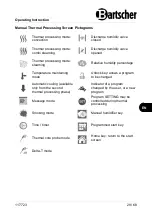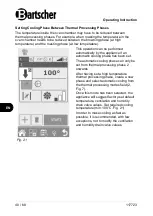
Operating Instruction
117723
25 / 68
EN
The oven is generally set in convection mode, with valve open and temperature
between 230 °C and 270 °C according to the type of product and browning that is to
be obtained, and ventilation between 4 and 6.
Frying
All breaded and pre-fried frozen foods can be fried in the device. In case of breaded
products, spray a thin layer of oil in such way that it is absorbed by the bread.
Frozen pre-fried products can be fried without adding oil.
Use non-stick aluminium trays or special frying baskets. Set the oven to convection
with the valve open, at temperature of 250°C and ventilation between 4 and 6.
Recommendations for cooking uniformity
The uniform cooking process may vary depending on type of prepared products. In
such case it is recommended to lower temperature and change (increase or
decrease) the fan rotation speed.
Using correct trays increases the general cooking uniformity of the oven. Always
select the tray with the minimum depth possible for the product to be cooked.
Aluminium trays offer more uniform cooking that steel trays.
Cooking in a vacuum bag
Product can be cooked directly inside a vacuum bag. This type of cooking allows for
particularly soft and flavoured meat to be obtained and at the same time decreases
spoilage of the product.
Pack the products into appropriate bags for vacuum cooking. Set the device to
"Mixed cycle" at 100% humidity and ventilation between 3 and 4. The cooking
chamber temperature must be maximum 3 °C-5 °C higher than the temperature
which the core must reach. E.g. for an average fillet (60°C in the core) set the
device temperature at 63 °C.
Pasteurisation in a container
In that process the product is considered pasteurised when the core temperature
reaches a value between 83 °C and 85 °C.
Depending on the type of product, dimensions of the container and amount of
product it contains, the time of reaching the core temperature may vary. We
recommend to use the core probe on a sample container (perforating the lid to allow
the probe to enter) in order to detect the temperature of the entire production batch.
At the end of cooking the product must be quickly cooled down to +3°C to end the
pasteurisation process.


